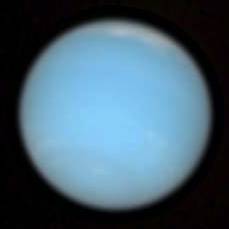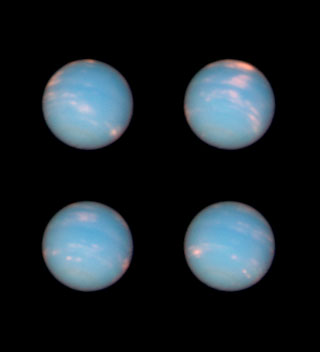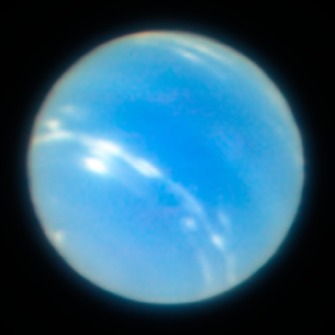NEPTUNE : PHYSICAL CHARACTERISTICSDistances to Neptune from our Sun averages some 29.9 A.U. or 4.3 billion kilometres, being about two-thirds (19.2/29.9 AU) further away than the similar sized planet of Uranus. From the orbit of Neptune, our Sun appears like a very bright star of -19 magnitude, whose very small apparent diameter subtends around 1.1 arcmin. This may varies in size throughout the orbit by only about 2% to 3%. Indeed, Neptune is so far from the Sun that the average observed diameter is merely 2 arcsec or only 1⁄1800th of Earth (1°). We find that that the very small brightness differences between each opposition and conjunction are just 0.2 magnitude (7%.)
Neptune in its long orbit takes some 164.79 years (164 years 10 month 17.0 days) to completely encircle the Sun, crossing on each constellation of the zodiac approximately averaging every fourteen years. Since found in 1846, it has yet only just complete one whole orbit. We recently celebrated this on Sunday 10th July 2011), where the distant planet returned to an almost identical place within the constellation of Aquarius. Exact positions were not exactly the same because of these same small perturbations that was noticed in the original discovery of Neptune have slightly changing the orbit. Its second orbit since discovery will again complete on 24th August 2176. For many years our knowledge was thwarted by even the largest telescopes discovering any of Neptune’s secrets — including properties as the diameter, composition and nature. Little was known about Neptune, until Voyager 2 had a brief encounter with the planet during August 1989. We knew only that the atmosphere was methane-rich, accounting for its observed blue-green colour. Methane happens to absorbs much of the faint red sunlight, which makes the visual rich blue colour. First impressions sometimes convince novices that its appearance looks very similar images of the watery Earth from space Earth. In fact, there is no true water or any ocean-like familiarity here. Perhaps the only thing in common with Earth is the axial tilt of 29½°, but here the resemblance stops. Neptune’s equatorial diameter is now known to be 44,000 kilometres. This makes it just a fraction smaller than Uranus, but it is still four times the Earth diameter. By mass, it is about 17 times heavier than Earth but is about one-quarter less dense. Much of the planetary atmosphere was found to be composed of about 84% Hydrogen and 15% Helium, with the Methane content being the remaining about 3%. There had always some suspicion of faint belts across the planetary disk, and as the Voyager 2 drew closer, all was soon revealed.
Here many new discoveries were made. Perhaps one of the most startling discovery was the aptly named Great Dark Spot (GDR) on the cloud-base, and faint ‘cirrus like’ clouds of methane appearing above Neptune’ cloud-based surface. During 2003/04 observations by the 10-metre Hawaiian Keck II telescope had found that this large spot had vanished. It was further examined in September 2005 when the Hubble Space Telescope (HST) was reexamine the planet from afar. They then found the similar circumstances with the now totally missing GDR, but found new changes. (Fig. 2). On 12th July 2011, another set of images was taken by HST, and this time, they found complicated cloud patterns had developed in the Neptunian atmosphere. Further ground-based images were made in July 2018 by the European South Observatory (ESO) further showing continuing activity.
Why Neptune has such an variable and active atmosphere so far from the Sun is still not presently fully understood. It is speculated that Neptune may have seasons that change over 164 years, depending on place in its orbit. Like our Earth, a similarly strong magnetic field surrounds Neptune, being was found to be unusually tilted by some 50° against the rotational axis. An atmospheric daily rotational period of about 16½ hours was also discovered, being slightly slower than first thought. Intriguingly, the planet was found to be more active than ever imagined — specially surprising after Voyager 2 visit showed an apparently quite inactive atmosphere of Uranus. FUTURE NEPTUNE MISSIONSIn December 2004, NASA announced that it was considering a new exploratory mission called the “Neptune Triton Orbiter”, to both study and understand the outer planet atmospheric conditions. NASA was expected to launch the craft around 2014, whose nuclear-electric propulsion system would had be required to get there, as solar power does not work in the so far from the Sun. To be captured and then orbit Neptune, this spacecraft would need to travel through the Solar System helped by many gravity assists from the inner planets and Jupiter, before finally reaching the right trajectory and velocity to place the spacecraft an orbit in 2035. This project and plan has since been scapped for another day. Disclaimer : The user applying this data for any purpose forgoes any liability against the author. None of the information should be used for either legal or medical purposes. Although the data is accurate as possible some errors might be present. Onus of its use is placed solely with the user.Last Update : 08th August 2015 Southern Astronomical Delights © (2012) For any problems with this Website or Document please e-mail me. |











